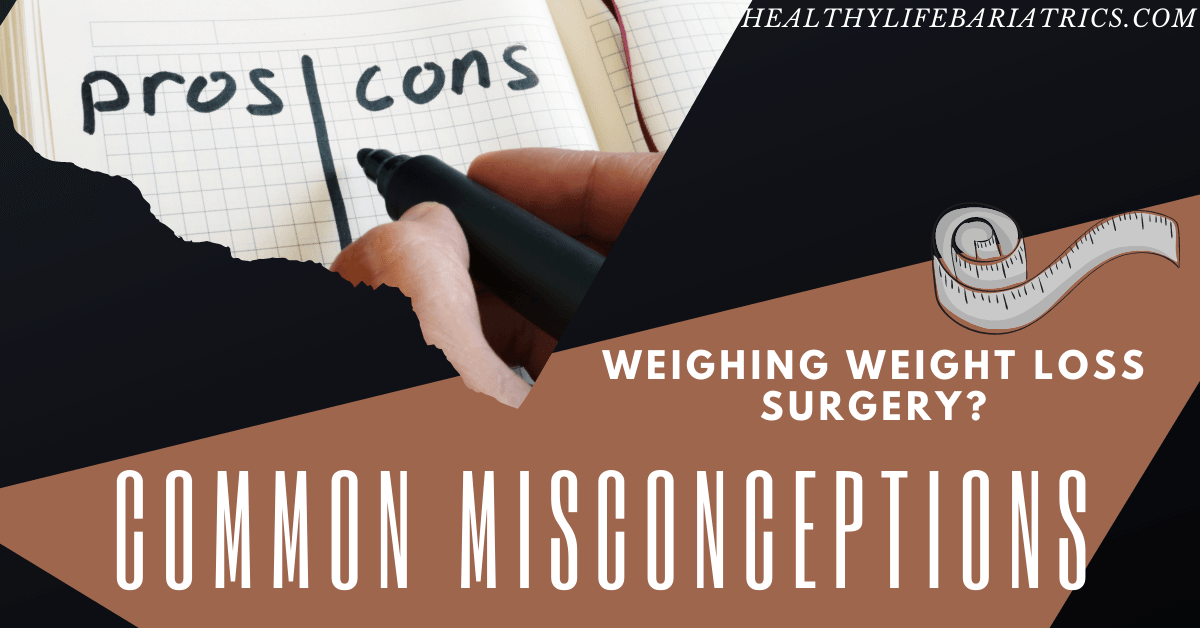According to the CDC, 42.4% of Americans are obese.
Losing weight is difficult and many diets fail since they are not sustainable.
There are also health, social, and economic effects associated with obesity. Effects like…
- Discrimination and social bias
- Increased medical costs
- And increased risk of chronic diseases like diabetes and heart disease
If you are obese, you might think that you’re stuck between two impossible choices. You either travel a near impossible weight loss journey or you deal with the economic and social stigma.
But that isn’t the case. You can lose more than 50 pounds in 3 months by investing in weight loss surgery.
Let’s dive in!
Common Misconceptions about Gastric Surgery
Misconception number 1: Weight loss surgery is for lazy people. All you need is diet and exercise.
People who sign up for weight loss surgery have already tried diet and exercise for years, possibly even decades. If you’re 20 or 30 pounds overweight then yes, diet and exercise will be enough. However, once you’re 50 or more pounds overweight, it becomes almost impossible to lose weight without the help of a bariatric surgeon.
Misconception number 2: You’ll just regain the weight after surgery.
A Swedish study found that people who had bariatric surgery were able to lose weight quicker and maintain their weight loss easier than those who did it with diet and exercise alone.
Participants also found that it had a positive effect on their diabetes and heart disease.
Misconception number 3: Weight loss surgery is risky and dangerous.
Bariatric surgery is among the safest surgical procedures. In fact, it’s more dangerous to not address obesity or weight concerns. When you’re obese, you are at a higher risk of dying from diabetes, heart disease, and cancer.
Now that we’ve busted a few myths, let’s cover the top 4 weight loss surgeries performed in 2020.
Intragastric Balloon

For over 20 years, the global medical community has been using the intragastric balloon to help thousands of people lose 10-15% of their overall body weight. In addition, patients with the intragastric balloon lost 3 times more weight than those who used diet and exercise alone.
The Weight Loss Surgery Procedure
The Intragastric balloon is an FDA-approved balloon made of soft and durable silicon. The procedure is done under anesthesia. A bariatric surgeon will place the balloon down the patient’s throat using a thin tube. Attached to this thin tube is a deflated balloon and a small camera.
Once the balloon is in the patient’s stomach, the bariatric surgeon will fill the balloon with a saline solution until it’s the size of a grapefruit. This process normally takes 20-30 minutes, and the patient will go home the same day.
Why Does the Gastric Balloon Work?
The Intragastric balloon works by filling a portion of the stomach. This slows the rate of which food enters the stomach and tells the brain, “I’m full”. A patient with the intragastric balloon will consume fewer calories because they will feel fuller for longer.
Gastric Balloon Eligibility
The intragastric balloon is perfect for you if…
- You have a BMI over 30
- You have never had any prior stomach surgeries
- You’re willing to commit to a healthy lifestyle (This includes eating healthy and going for regular medical check-ups)
The Pros and Cons of the Intragastric Balloon
The benefits of the intragastric balloon are…
- Lowers diabetes complications & risks
- Lowers risk of heart disease
- Allows for increased energy
- Increased body positivity
- Quick and safe procedure
- Not a permanent procedure
The cons include…
In rare cases, the balloon can cause nausea, vomiting, abdominal pain, and diarrhea. This is called “dumping syndrome”.
Follow-ups

After 6 months, your bariatric surgeon will remove the intragastric balloon. You will also have to meet with nutritionists, psychologists, and other medical professionals that’ll help you reach your goals. For the first week, you will be on a low-sugar, liquid diet. No solid foods are allowed. At the start of the second week, you can start eating soft foods. What are soft foods? Well, anything that you can mash up with a fork. You can then start eating regular food 3 weeks after the removal of the intragastric balloon.
Now that we’ve covered intragastric balloons, it’s time to cover Gastric Sleeve Surgery.
Gastric Sleeve Surgery
You can expect to lose 60-70% of excess weight within one year of undergoing gastric sleeve surgery. It’s easy to see why gastric sleeve surgery is becoming so popular.
The Weight Loss Surgery Procedure
Normally your stomach can hold 1 – 1.5 liters of food. After undergoing gastric sleeve surgery, your stomach will only be able to hold 50 – 150 ml of food, or the size of a banana.
The part of the stomach that’s removed is the longer side. This is also the part of the stomach that produces ghrelin or “the hunger hormone”. Not only will gastric sleeve surgery reduce the size of your stomach, but it reduces the amount of ghrelin released. This results in patients feeling fuller for longer.
Why the Gastric Sleeve Works
The gastric sleeve works in two ways…
- Reducing the size of the stomach, resulting in fewer calories consumed
- Reducing the amount of ghrelin released, resulting in feeling fuller for longer
Unlike other methods that rely solely on reducing the size of the stomach, or reducing hunger hormones, the gastric sleeve does both. This makes it a reliable way of losing excess weight, fast.
Gastric Sleeve Eligibility
Gastric sleeve surgery is for…
- Patients with a BMI over 35 with medical problems like diabetes and heart disease
- Patients with a BMI over 40 without any medical problems
The Pros and Cons
The pros of gastric sleeve surgery are…
- It’s safer than most other weight-loss surgeries
- The gastric sleeve promotes more weight loss than gastric banding
- Better absorption of vitamins and minerals
- There are no foreign objects placed in your stomach
- And food is better tolerated by the body compared to other weight-loss surgeries.
The drawback of gastric sleeve surgery is…
- Part of your stomach is permanently removed
Follow-up after Vertical Sleeve Gastrectomy
After your gastric surgery is complete, you’ll have to stay 1-2 days in the hospital. Once they’ve released you, avoid any strenuous activity for the next 2-3 weeks. After the 3-week mark has passed, you can go back to your regular routine.
Try exercising on a regular basis. Exercises like…
- Walking
- Jogging
- Bodyweight exercises
This will promote weight loss and help keep you healthy.

Also, your doctor will ask you to start taking supplements like…
- Vitamin A
- Vitamin C
- Calcium
- Vitamin D3
- Multivitamin
Always take these supplements on a full stomach as many of these vitamins are fat-soluble. Meaning they are easily absorbed with fat.
Gastric Bypass Surgery
Compared to the two weight-loss surgeries we’ve already covered, the gastric bypass is unique in that it reroutes your digestive system after limiting the amount of food your stomach can hold.
The Gastric Bypass Procedure
The surgeons can do the gastric bypass in two ways. Your bariatric surgeon will either perform the stomach surgery open or will use a laparoscope, which is a tiny camera inserted into your belly.
First, your surgeon will divide your stomach into two parts. A small upper pouch (This is where food will pass through) and a larger lower pouch.
Next, the surgeon will attach part of your small intestine to your upper pouch. This allows food to travel from your esophagus, through your upper pouch, and into your small intestine.
The most popular way of doing a gastric bypass is with laparoscopy. Your bariatric surgeon will make five tiny cuts on your abdomen. The surgeon will insert the laparoscopic camera and other surgical tools through these openings. Your surgeon will be able to view the goings on inside your abdomen by way of a video monitor positioned nearby.
This procedure typically takes 2-3 hours.
The reason most gastric surgeons choose laparoscopy over open surgery is that it’s less painful. Patients also have a shorter hospital stay to look forward to and quicker recovery time. With a laparoscope, there is also a lowered risk of infection.
Why Gastric Bypass Works
The gastric bypass works similarly to the sleeve. It reduces the capacity of the stomach, allowing patients to feel fuller, quicker. Also, since the long side of the stomach is absent after both procedures, it reduces ghrelin, “the hunger hormone”.
Gastric Bypass Eligibility ?
The gastric bypass is perfect for you if…
- You have a BMI over 35
- You’re a non-smoker
- You have diabetes or reflux disease
- You don’t have a history of stomach ulcers
The Pros and Cons
The benefits of the gastric bypass are…
- Promotes slightly more weight loss than the gastric sleeve
- Helps control diabetes and other chronic disease associated with obesity
- Food is easily absorbed
The drawbacks of the gastric bypass are…
- It cannot be performed on someone with previous stomach operations
- Cannot be performed on someone prone to ulcers
- Cannot be performed on a smoker because smoking can cause stomach ulcers
- “Dumping Syndrome” is commonly associated with gastric bypass surgery
Follow-up After Gastric Bypass
You can return to work within 14 days of the operation. You’ll need to take daily vitamin supplements. Your surgeon will follow-up with you regularly. These meetings will usually include a physical exam and tailored advice for staying the course along your weight loss journey.
Adjustable Gastric Band

The adjustable gastric band is a popular weight loss procedure because it doesn’t involve cutting or placing foreign objects inside the patient’s stomach, and it’s easily reversible. However, it does have its drawbacks. It has the lowest percentage of excess weight lost, at only 40%. This means if you’re 100 pounds overweight, you’ll only lose 40 pounds.
The Gastric Band Procedure
Your bariatric surgeon will place a band around the top of your stomach. This band will be connected to a thin tube and a port. This will allow your bariatric surgeon to inject fluid into the band, which tightens it.
It will leave a small pouch at the top of the band. Your bariatric surgeon will control the size of that pouch by loosening or tightening the band. The band needs to be tight enough to slow digestion, but not too tight that it causes vomiting.
Also, the band must be adjusted every month or so to reach optimal tightness.
Why the Gastric Band Works
The Gastric band works by slowing digestion of your food, allowing you to eat less. However, you will need to eat your food slowly and chew carefully so that you don’t experience vomiting and nausea.
Gastric Banding Eligibility
Gastric banding is for…
- Patients with a BMI over 35
- Elderly patients that have a high risk of infection
- Patients that are unwilling to undergo a permanent procedure
The Pros and Cons
The benefits of the gastric band include simplicity and the fact that the bariatric surgery is reversible. There is no cutting or removal of tissue of any kind.
However, the gastric band is no longer as recommended as other gastric surgeries like the sleeve gastrectomy and intragastric balloon. That is because the Lap-Band often requires monthly adjustments. Furthermore, there is a 30% chance you may need a re-operation.
As for losing excess weight, you can expect to lose only 40% of your excess weight, which is inferior to the 60%+ fat loss offered by the gastric sleeve.
Follow-up for Gastric Banding
A gastric band operation often takes several hours, but patients go home the same day. You’ll also need to take pain medication for a few days after surgery.
Like with all weight loss surgeries, you’ll need to attend regular appointments with your nutritionist, both before and after surgery.
For the first 2 weeks after surgery, only liquids are allowed. From 2 to 4 weeks, you’ll start eating soft foods, and one month after surgery you can start eating regular meals.
After each adjustment, you’ll need to progress from liquids to soft to regular foods again. Therefore, the gastric band has the biggest impact on your daily eating habits.
Conclusion
Weight loss is a tough, and grueling journey. Most quit. Those who do not are mentally burnt out and often resort back to their old habits. Weight loss surgeries are not cheat codes, but it will make your weight loss journey a lot easier and more sustainable.
To get the body you always wanted, book a virtual consultation with Dr. Moein at Healthy Life Bariatrics. Dr. Moein specializes in bariatric weight loss surgery and cosmetic body contouring in Los Angeles, CA and is fully equipped with a qualified team to help you achieve your weight loss goals.






